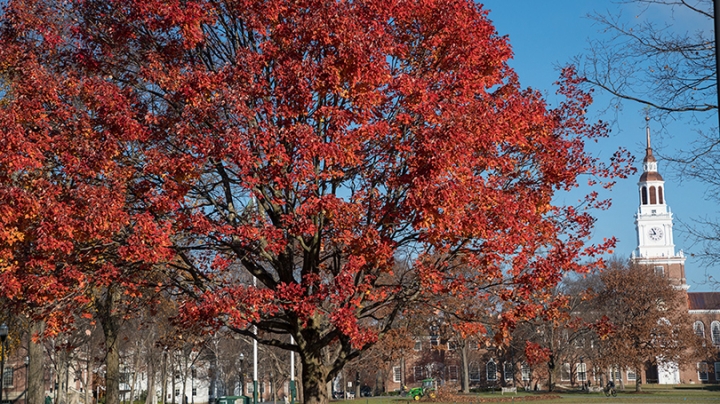The annual homecoming bonfire will light up the Green as scheduled on Friday, Oct. 26—with structural and programmatic changes that address safety concerns raised by Hanover town officials over the summer.
“Dartmouth takes the issues raised by Hanover officials seriously, and I’m gratified that we will host an event that honors the College’s homecoming tradition while respecting the town’s safety requirements,” says Interim Provost David Kotz ’86.
In addition to the structure of the bonfire itself, an area of great concern to the town is an increasing number of incidents of high-risk behavior exhibited by some students and alumni. Dartmouth will take steps to address these concerns and has assured the town that rules pertaining to the bonfire, particularly a prohibition against touching the fire, will be strictly enforced.
“Dartmouth Night’s bonfire is a tradition that began in 1895 and has evolved over the years,” says Kotz. “It is a moment of pride for the Dartmouth community and an opportunity to build and strengthen bonds across generations. However, if we want it to continue we must better embody our value of civility as we celebrate in a safe environment.”
The continuation of the bonfire in future years depends on the successful implementation of the changes. As Kotz notes, “Students who try to touch the fire or engage in misconduct at homecoming not only place their Dartmouth careers at risk, they also threaten the future of a much beloved Dartmouth tradition.”
“As we work to make the bonfire safer, it is our hope that alumni and older students will support our efforts by not encouraging first-year students to misbehave,” he says.
Each fall, homecoming weekend draws thousands of people to the Green for the Dartmouth Night bonfire. In June, the town notified the College that it would no longer issue an outdoor-activities permit for the three-story bonfire, citing the risk that the structure could collapse and cause injuries as well as concerns about high levels of intoxication and dangerous student behavior.
In response, the College convened a working group charged with proposing changes that would maintain the spirit of Dartmouth Night while meeting the town’s requirements—a safer bonfire structure and improved crowd management.
The recommendations the working group submitted to Kotz—which he subsequently shared with the town—do just that. As a result, Hanover issued a permit for the event.
A Bonfire Redesign
The working group, chaired by Associate Professor of Engineering Douglas Van Citters ’99, Thayer ’03, ’06, studied the problem throughout the summer in a process that included reaching out to students, alumni, faculty, staff, and other community members for input.
“As an engineer, and a member of the faculty, my broader job function is to solve problems and teach others how to solve problems,” Van Citters says. And as an alumnus, he says, he has a personal stake in seeing the Dartmouth Night tradition continue.
“My allegiance to Dartmouth as an alum and now as a community member is such that I was 100 percent committed to seeing homecoming through in such a way that everybody would be able to enjoy it, have fun, and relate back to their time at Dartmouth, while still making sure we met the needs of all of the stakeholders,” Van Citters says.
The redesigned bonfire will look very familiar to students and alumni, he says. “The fundamental design uses exactly the same amount of wood, but the shape is a little bit squatter.” The design shortens the structure by several feet, lowering its center of gravity to improve stability and increase the chances that the structure will collapse inward.
In addition to redesigning the bonfire, Dartmouth will implement several changes to better manage the Dartmouth Night crowd, improve safety, and make the event more accessible. The main activities of the night will be consolidated on the Green, with staging and sound improved to make the evening’s events visible and audible to more of the crowd than in the past. (See list of changes.)
The former practice of first-year students running around the fire as many times as their class year (and, in recent years, that number plus 100), will no longer be permitted. In addition, students who attempt to touch the fire—one of the town’s most serious concerns—will face judicial action; in recent years this has included suspension for as much as a full year.
Vice President for Alumni Relations Cheryl Bascomb ’82, a member of the working group, expressed confidence that returning alumni will appreciate that the changes “are the result of our shared commitment to campus safety and to preserving the incredible spirit of homecoming.”
Along with Van Citters and Bascomb, working group members were Senior Associate Dean of Student Affairs Elizabeth Agosto ’01; David Bradley ’58; Amber Bryant ’12; Associate Professor of Physics and Astronomy and house professor Ryan Hickox; Executive Director of Conferences and Events E.J. Kiefer; Runze Penny Liu ’20; Interim Director of Safety and Security Keiselim Montás; Director of Alumni Leadership Liz Nuñez; Associate Dean for Student Life Eric Ramsey; and Mary Tobin ’20.
“We appreciate Dartmouth’s commitment to address the crowd control and safety issues raised by the town,” says Hanover Town Manager Julia Griffin. “If these modifications are successful, it will allow students and alumni to continue to enjoy homecoming for years to come.”
Hannah Silverstein can be reached at hannah.silverstein@dartmouth.edu.

